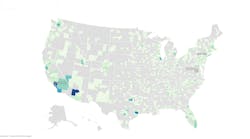Latest from Market Sales Estimates
AIA’s Architecture Billings Index slides in December
Demand for design services from architects dipped last month, according to the American Institute of Architects (AIA). The pace of decline during December accelerated from November, posting an Architecture Billings Index (ABI) score of 42.6 points from 46.3 points (any score below 50 points indicates a decline in firm billings).
“Since the national economic recovery appears to have stalled, architecture firms are entering 2021 facing a continued sluggish design market,” said AIA Chief Economist Kermit Baker in the press release. “However, the recently passed federal stimulus funding should help shore up the economy in the short-term, and hopefully by later this year there should be relief as COVID vaccinations become more widespread.
“Recent project inquiries from prospective and former clients have been positive, suggesting that new work may begin picking up as we move into the spring and summer months.”
Leading indicators improve in 4Q 2020
The Conference Board Leading Economic Index (LEI) for the U.S. increased +0.6% in November to 109.1 (2016 = 100), following a +0.8% increase in October and a +0.7% increase in September. “The U.S. LEI continued rising in November, but its pace of improvement has been decelerating in recent months, suggesting a significant moderation in growth as the U.S. economy heads into 2021,” said Ataman Ozyildirim, senior director of economic research at The Conference Board, in the press release. “Initial claims for unemployment insurance, new orders for manufacturing, residential construction permits, and stock prices made the largest positive contributions to the LEI. However, falling average working hours in manufacturing and consumers’ worsening outlook underscore the downside risks to growth from a second wave of COVID-19 and high unemployment.”
Freight rail traffic sees nice bump for the week ending Jan. 16
Total U.S. weekly rail traffic was 528,547 carloads and intermodal units, up +5.8% compared with the same week last year. Total carloads for the week ending Jan.16 were 232,550 carloads, down -2% compared with the same week in 2020.









